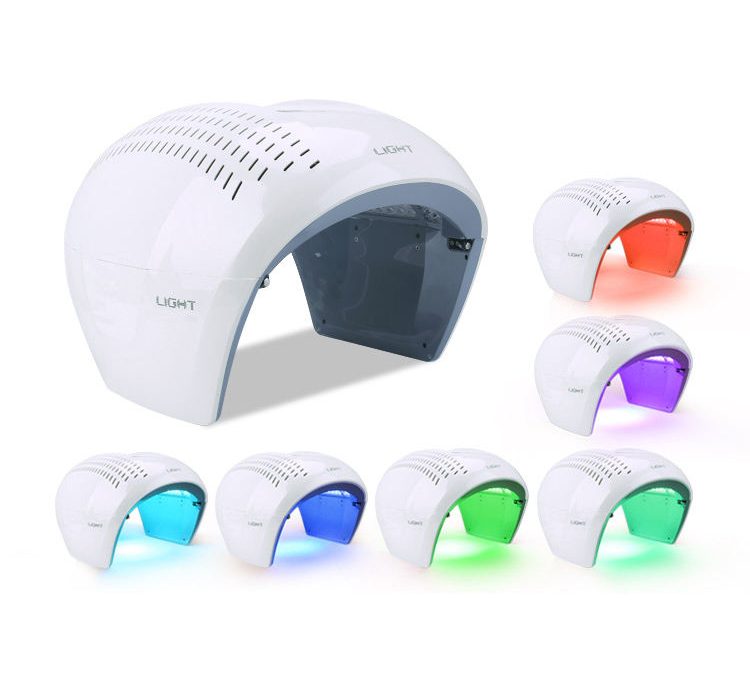Foldable led light therapy skin tightening machine LB340
led light therapy Facial Beauty mask SC256
Light therapy acne spot treatment machine LB281
7 Colors Led Light Therapy Machine SC118C
Led Light Therapy Face Rejuvenation Machine SC412E
7 Color Led Light Therapy Skin Care PDT Machine LB380
Led Light Therapy Facial Beauty Device LB463
EMS Photon Light Therapy Device LB357
Best Professional Led Light Therapy Machine GL034
Salon Use PDT Skin Rejuvenation Beauty Machine LB054
LED light therapy is a well-known non-invasive skin treatment for wounds, acne, sun damage, and other skin issues.
People have the option of using a gadget at home or receiving LED light treatment in a dermatologist’s office.
The procedure stimulates the skin’s natural healing processes to mend the skin by using light of various wavelengths. To see benefits, more sessions are required.
We will talk about what happens before, during, and after LED light therapy, its average cost, risks, benefits, and other important details about this treatment.
Let’s get going!
What is LED light therapy?
LED (light-emitting diode) is a non-invasive procedure that is used in treating various skin issues. Acne, fine wrinkles, and psoriasis are just a few of the skin issues and conditions that LED light treatment treats. It is available in a variety of forms, including red light LED therapy and blue light LED therapy, which are occasionally combined.
When a LED light device is used on your skin, it can penetrate deep into the layers of tissue below your skin’s surface, reaching areas that most topical creams cannot access. This allows it to treat deeper conditions such as broken capillaries or wrinkles as well as superficial ones like acne scars or sun damage.
Are there different kinds of LED light therapy?
Different wavelengths that correlate to different visible colors are used in LED light therapy. Various shades pierce the skin at varying speeds.
Blue light therapy: This type of therapy uses blue-spectrum LED lights to target bacteria in your pores without damaging your skin. It also reduces inflammation. Blue light therapy can be used alongside other treatments or on its own.
Red light therapy: This type of therapy uses red-spectrum LED lights to treat discoloration caused by acne scarring (pigmentation). Red light therapy uses red lights that penetrate deep into the skin to stimulate collagen production and speed up healing.
Both types of light can be used on the face or body, but they’re designed for different purposes. Red light helps with blood circulation and collagen production, while blue light helps reduce inflammation and kill acne-causing bacteria. Both types of lights have been shown to improve wrinkles and other signs of aging.
There are many different types of LED devices on the market, with some offering more potent wavelengths than others. For example, red LED devices are often used for anti-aging and acne treatments, while blue LED devices are used for skin tightening. It’s important to know that the effectiveness of each treatment depends on your specific condition and on how your body responds to the light.
What skin issues does LED light therapy treat?
A variety of skin issues and conditions are treated with LED light treatment, including wrinkles, wounds, sun damage, moderate to mild acne, eczema, rough, scaly, and precancerous skin lesions (actinic keratosis), rosacea, psoriasis, as well as uneven skin texture and tone.
Almost all skin types can safely use LED light therapy. Pregnant women, those with certain chronic medical issues, and anyone with overly large or severe skin concerns should avoid using LED light treatment.
Does LED light therapy Machine work?
According to research, LED light treatment can help lessen and treat a variety of skin problems. However, you must receive regular treatments if you want to notice improvements in your skin.
In-office LED light treatment is more successful than at-home devices because it employs stronger intensities. You probably won’t get significant anti-aging or acne-reducing effects using LED masks and other portable devices. However, you might notice slight changes in the appearance of your skin.
How long does it take for LED light therapy to work?
You usually require a series of in-office treatments to experience any real advantages. For roughly a month, you could need treatment once a week. Then you may require maintenance procedures every month or only a few months.
Some household appliances could also demand a sizable time investment. For four to five weeks, you might need to use your gadget twice daily for 30 to 60 minutes. Other gadgets only require a few minutes per day.
Who should not have LED light therapy?
Not everyone is a candidate for LED light treatment, especially those who:
1.Have a history of certain illnesses, such as genetic eye problems and skin cancer.
2.Use certain drugs like lithium and isotretinoin, which make them more sensitive to sunlight.
What happens before LED light therapy?
You must have a clean, makeup-free face before treatment, whether it is in-office or at home. You might undergo additional treatments, such as a facial, before LED light therapy in a spa or dermatologist’s office. To shield your eyes from the bright lights, put on safety goggles.
What happens during in-office LED light therapy?
A home gadget or a professional’s office can both be used for LED light therapy.
After putting on your goggles for professional treatment, the dermatologist can ask you to lie down in front of LED lights or apply a LED wand to your body.
Up to ten sessions can be required to complete your treatment and each session lasts roughly 20 minutes.
After one session, a person might have to come back regularly for maintenance sessions.
LED devices that may be used at home might be more practical because they don’t require appointments. They might not be as effective as medical interventions, though.
It’s crucial to follow the manufacturer’s instructions while using a LED light device at home. These tools usually take the shape of a mask that is applied to the face for a while or a wand that is applied to the skin.
Every area of the body, including the face, hands, neck, and chest, can benefit from LED light treatment.
There is no need for a recuperation period after therapy.
What happens after LED light therapy?
You can resume your normal activities following in-office or at-home LED light therapy.
After the treatment, you should avoid direct sunlight for some days and make sure you apply sunscreen often. This is because UV rays can cause skin damage if used soon after LED light therapy.
Most people start to see results after one session of LED light therapy, but we recommend finishing all sessions before making a final evaluation of its effectiveness.
What are the risks or side effects of LED light therapy?
LED light treatment is risk-free. There is no burning or pain associated with this noninvasive process. To ensure you’re using the gadget appropriately, make sure to put on eye protection, like goggles or sunglasses, and adhere to the instructions strictly.
Some of the potential side effects of LED light therapy are redness, inflammation, soreness in the skin, and rashes.
If a person uses topical therapies that make them more sensitive to sunlight or certain drugs, such as isotretinoin (Accutane) for acne, they shouldn’t utilize LED therapy.
Before using LED light treatment, those with skin issues should consult a dermatologist.
While LED light treatment appears to be safe in the short term, there is less knowledge about its long-term safety, experts do issue a warning.
What is the average cost of LED light therapy?
The average cost of a LED light treatment ranges from $25 to $250. The board-certified dermatologist, the place where you carried out the treatment, duration, and complexity of the cosmetic surgery all affect how much LED light therapy will actually cost you.
Benefits of LED light therapy
The benefits of LED light therapy include:
1.It enhances the skin’s texture and tone
LED light therapy is an effective treatment for a wide range of skin conditions. The light from the LED light therapy device is absorbed by the skin tissue, stimulating collagen production and improving elasticity. This improves the overall appearance of the skin, making it firmer and brighter.
2.It is a non-invasive procedure
Unlike other types of light therapy, LED light therapy doesn’t require any invasive procedures or injections.
It is safe and non-invasive meaning the risks involved are minimal unlike some other treatments such as laser treatments which can cause burns if not used correctly by a trained professional.
LED light treatment does not harm the skin or cause damage to vital organs.
3.No downtime required
Another benefit of LED light therapy is that it has a fast recovery time and no downtime. You can go back to work or your daily activities after treatment without having to bother about any form of discomfort.
4.Reduced inflammation
LED light therapies are effective at reducing inflammation in the body. This is especially beneficial for those who have acne or rosacea. The redness and swelling caused by these conditions can be greatly reduced when using LED light therapy by increasing circulation and improving blood flow to the affected areas.
5.It is safe for all skin types
Another advantage of LED light therapy is that it’s safe for all skin types — as long as you don’t have certain pre-existing medical conditions or allergies to medications or foods that could make your reaction to treatment worse than normal. Consult your doctor before utilizing LED light treatment if you have any concerns about it because of your health.
Conclusion
LED light therapy is a non-invasive treatment that involves exposing your skin to specific wavelengths of light.
The idea behind this type of treatment is that the light will penetrate into your skin and stimulate the production of collagen and elastin in order to improve its appearance.
LED light treatment is effective in reducing the appearance of sun damage and pigmentation.
However, we would not recommend using this treatment as a cure-all for all your skin issues. As with all treatments, results vary from person to person depending on the severity of the problem, so you should always consult your dermatologist before beginning any treatment.
When used as directed, LED light therapy can help heal acne, reduce the appearance of wrinkles and improve the overall look of your skin.
It’s important to note that there are many different types of LED devices on the market. While some are more effective than others, they all produce similar results when used correctly. So it’s not about the brand or model — it’s about how well you use it.

